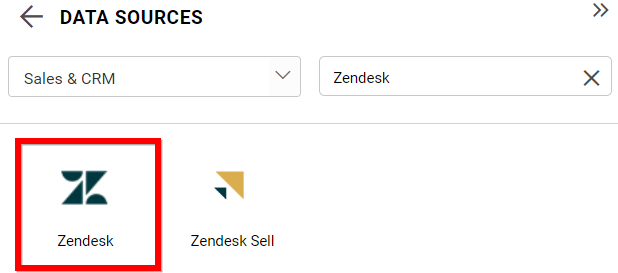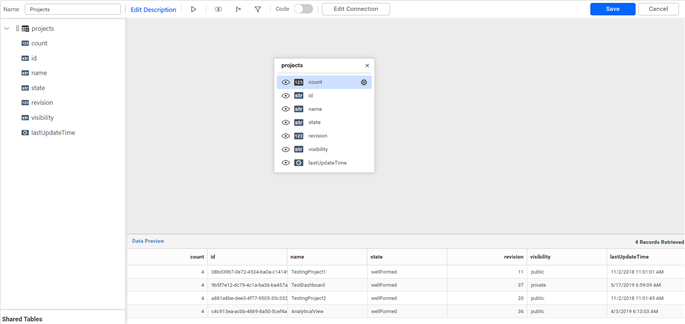Connecting Bold BI to Zendesk data source
The Bold BI dashboard designer supports connecting to Zendesk web services through the REST API.
Choose Zendesk data source
To configure the Zendesk data source, follow the below steps:
-
Click on the Data Sources button in the configuration panel to add a new data connection.

-
Click CREATE NEW to launch a new connection from the connection panel.
-
Select the Zendesk connection in the connection panel.

NOTE: You can also create a data source from the home page by clicking on the Data Sources menu on the left menu panel and selecting Create Data Source from the data sources page.

Create Zendesk data source
Once you click on the data source, the NEW DATA SOURCE configuration panel will open. Follow the below steps to create Zendesk data source.
-
Enter a name and description (optional) for the data source.
-
Enter a valid Zendesk REST API endpoint in the URL textbox. Refer to the Zendesk API documentation for more details.
Example:
https://<:yourdomainname>.zendesk.com/api/v2/<:your_endpoint> -
Select the GET method for the REST API in the Method combo box.
-
In the Max Rows field, enter the maximum number of rows to be fetched from the Zendesk data source. This value is used for data pagination.
-
Choose a time interval for Refresh Settings using the combo box to periodically trigger the REST API request and keep the data in sync with our dashboard.
-
Select JSON data type in the Data Format combo box.
-
Choose an Authentication Type from the dropdown menu.
-
To connect based on the chosen Authentication, please refer to the Supported Authentication Types.
You also have the option to edit the connection information set here using the Edit Connection option.
Authentication for Zendesk
Basic Authentication
Before accessing your endpoint, make sure that Password access is enabled in your account.
-
Login to your Zendesk account.
-
Click on Admin(gear icon) on the left side bar.
-
Navigate to Admin -> Channel -> API and enable Password access.

Set Authentication Type as Basic http Authentication and enter your Zendesk’s username and password.
API Token Authentication
Before accessing your endpoint, make sure that Token access is enabled in your account.
-
Login to your Zendesk account.
-
Click on Admin(gear icon) on the left side bar.
-
Navigate to Admin -> Channel -> API and enable Token access.

Set Authentication Type to None. Generate Base64 encoded string of your <:email_address>/token:<:api_token> and pass the encoded string as a Header with the key “Authorization” and the value “Basic”. password.
Additional information
| Max Rows | Most REST APIs return only a limited amount of data on a single API request. To retrieve the necessary amount of data, you can set a value in this field. Pagination is handled internally and will fetch the required data. |
| Refresh Settings | The period of time before the next refresh call is triggered. This will automatically trigger a call for the API configured in the data source to keep the data up to date. If you do not want to sync your new data, choose 'Never'. |
Setting up the URL
- Query the /tickets.json endpoint.
- From the listed information, get the ID of the specific ticket.
Replace it in the URL to query a particular ticket:
https://domain_name.zendesk.com/api/v2/tickets/12.json
For more information on the API endpoints available for this data source, refer to their official API Documentation
Sample queries
Tickets
https://syncdb.zendesk.com/api/v2/tickets.json
Workspaces
https://syncdb.zendesk.com/api/v2/workspaces.json
Groups
https://syncdb.zendesk.com/api/v2/groups.json
Satisfaction ratings
https://syncdb.zendesk.com/api/v2/satisfaction_ratings.json
Preview and data import
-
Click Preview & Connect to connect with the configurations that have been set.
-
The Choose Schema(s) dialog opens. The schema represents the key fields of JSON data retrieved from Zendesk Rest API request. This dialog displays a list of schemas in a treeview and its corresponding values in grid for preview. Select required schema(s) from treeview to use in designer and click Connect.

-
Now, the data design view page with the selected table schema opens. Drag and drop the table.

-
Click Save to save the data source with a relevant name.
Related links
Dashboard Designer Walkthrough
Zendesk Support API Rate Limits
Zendesk Limitations of API Pagination